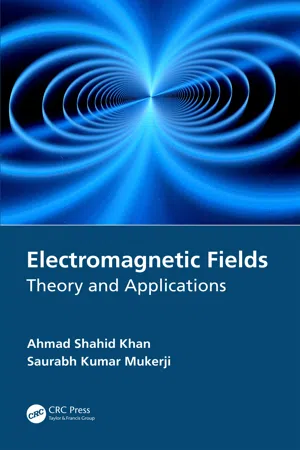
- 770 pages
- English
- ePUB (mobile friendly)
- Available on iOS & Android
About this book
The study of electromagnetic field theory is required for proper understanding of every device wherein electricity is used for operation. The proposed textbook on electromagnetic fields covers all the generic and unconventional topics including electrostatic boundary value problems involving two- and three-dimensional Laplacian fields and one- and two- dimensional Poissonion fields, magnetostatic boundary value problems, eddy currents, and electromagnetic compatibility. The subject matter is supported by practical applications, illustrations to supplement the theory, solved numerical problems, solutions manual and Powerpoint slides including appendices and mathematical relations. Aimed at undergraduate, senior undergraduate students of electrical and electronics engineering, it:
- Presents fundamental concepts of electromagnetic fields in a simplified manner
- Covers one two- and three-dimensional electrostatic boundary value problems involving Laplacian fields and Poissonion fields
- Includes exclusive chapters on eddy currents and electromagnetic compatibility
- Discusses important aspects of magneto static boundary value problems
- Explores all the basic vector algebra and vector calculus along with couple of two- and three-dimensional problems
Frequently asked questions
- Essential is ideal for learners and professionals who enjoy exploring a wide range of subjects. Access the Essential Library with 800,000+ trusted titles and best-sellers across business, personal growth, and the humanities. Includes unlimited reading time and Standard Read Aloud voice.
- Complete: Perfect for advanced learners and researchers needing full, unrestricted access. Unlock 1.4M+ books across hundreds of subjects, including academic and specialized titles. The Complete Plan also includes advanced features like Premium Read Aloud and Research Assistant.
Please note we cannot support devices running on iOS 13 and Android 7 or earlier. Learn more about using the app.
Information
1 Introduction
1.1 Introduction
1.2 Historical Perspective
1.2.1 Conceptual Stage
1.2.2 Era of Basic Laws
1.2.3 Era of Inventions
1.3 Sphere of Electromagnetics
1.3.1 Tiny Charged Particles
1.3.2 Behaviour of Tiny Charged Particles
1.3.3 Role of Maxwell Equations
Table of contents
- Cover
- Half-Title
- Title
- Copyright
- Contents
- Preface
- Authors
- Chapter 1 Introduction
- Chapter 2 Field Applications
- Chapter 3 Coordinate Systems and Vector Algebra
- Chapter 4 Vector Calculus
- Chapter 5 Electric Field Intensity
- Chapter 6 Electric Flux Density
- Chapter 7 Potential and Potential Energy
- Chapter 8 Electrical Field in Materials
- Chapter 9 Electrostatic Boundary Value Problems Involving Laplacian Fields
- Chapter 10 Electrostatic Boundary Value Problems Involving Poisson’s Fields
- Chapter 11 Steady Magnetic Fields
- Chapter 12 Fields in Magnetic Materials
- Chapter 13 Magnetic Circuits
- Chapter 14 Magnetostatic Boundary Value Problems
- Chapter 15 Time-Varying Fields
- Chapter 16 Electromagnetic Waves
- Chapter 17 Reflection and Refraction of Electromagnetic Waves
- Chapter 18 Transmission Lines
- Chapter 19 Waveguides and Cavity Resonators
- Chapter 20 Radiation Mechanism
- Chapter 21 Eddy Currents
- Chapter 22 Electromagnetic Compatibility
- Index